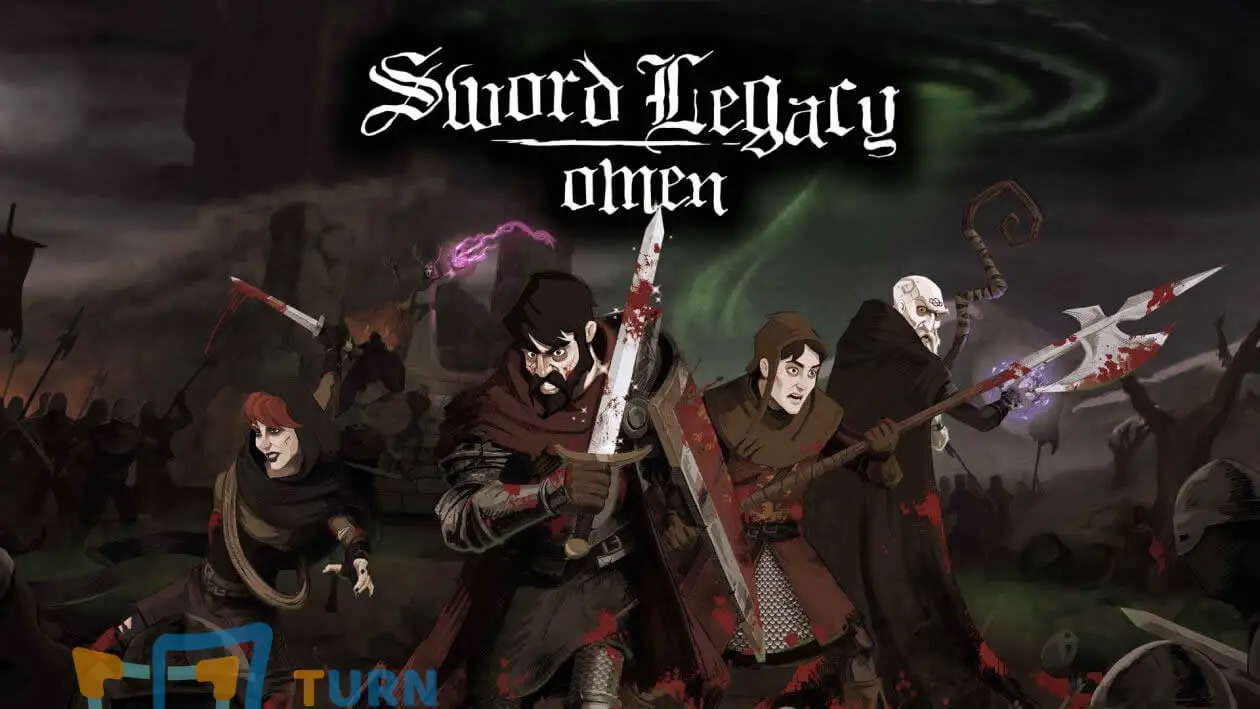Just recently, we’ve taken a look at some grid-based tactical games to play while waiting for Triangle Strategy. One game on that list – Sword Legacy Omen, has really caught my eye. Developed by Firecast Studio and Fableware Narrative Design, it purports to be a twist on the legend of Uther Pendragon – father of King Arthur. While not a game-changer, this 2018 title is a fun journey that doesn’t take too long to get through – ideal for waiting out that last week before the anticipated release.
Story and Setting
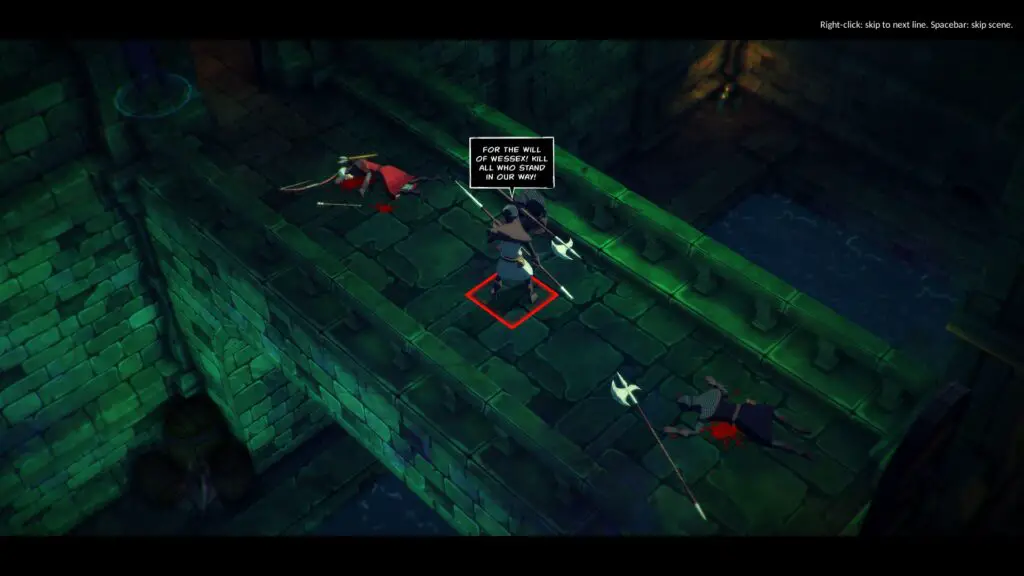
In the Arthurian legend, Uther was a prince and later a king who – in some versions aided by Merlin – carried out an affair with Igraine, wife of Duke Gorlois. The two were wed after Gorlois’ death, and their son was Arthur – the Once And Future King. While all the major players are represented in the game – the story told in Sword Legacy Omen is rather different. Here, Uther is the Knight-Commander of Mercia: grim, harsh, and dedicated. He and Igraine are secret lovers, but Igraine isn’t betrothed to anyone. When Gorlois attacks Mercia, Uther’s lord Leof is killed and Igraine captured. This prompts Uther to gather what allies he can, in order to avenge this wrong.
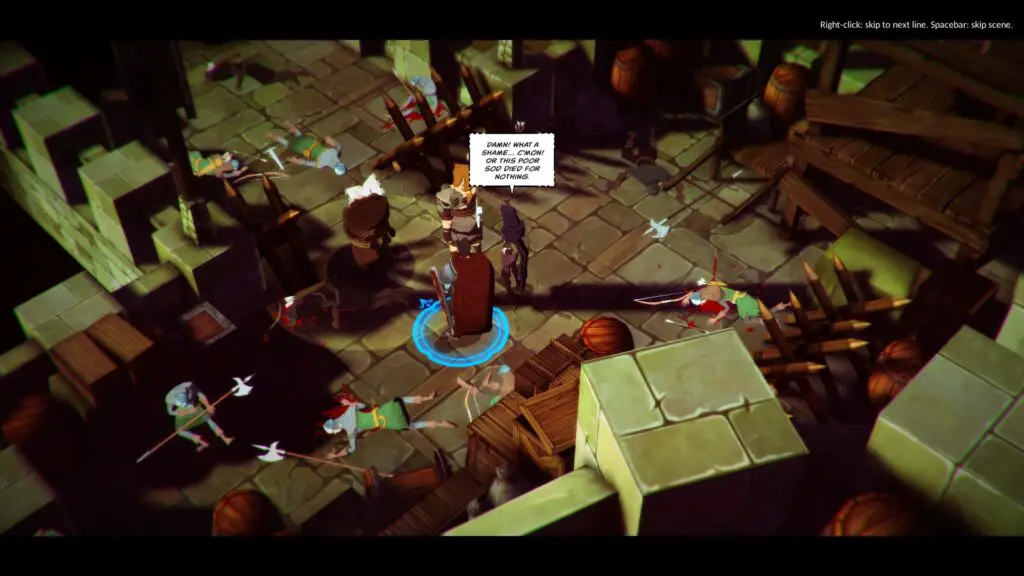
Sword Legacy Omen is best thought of as taking place in its own setting. It really doesn’t have much to do with the actual Arthurian legend. The only thing that’s common to both stories are the characters. The Britannia of the game is a place where clockwork mechanisms, literacy, and other anachronisms of Britain during the Dark Ages are common. The monotheistic religion that’s slowly displacing the old faith has all the trappings of the medieval Christian Church – but worships a goddess called Terah. There’s even some lore about a legendary Empress by the name of Britannia, who once united the land. If you’re looking for a game that’s faithful to the history and the tales of old – this isn’t it.
On its own, the setting is detailed enough, and the game features a decent amount of lore. You can discover the world’s story not only through the narrative and the conversations, but also by finding the various lore pickups, scattered around every map. For example, there’s an entire well-thought-out tale about sorcery, taking place in the game’s universe. The presence of the mystical faye imbues the world with subtle natural magic. While human wizards, like Merlin and Gorlois, approach sorcery as a science. It definitely feels like the game only scratches the setting’s surface, and there is plenty more to explore.
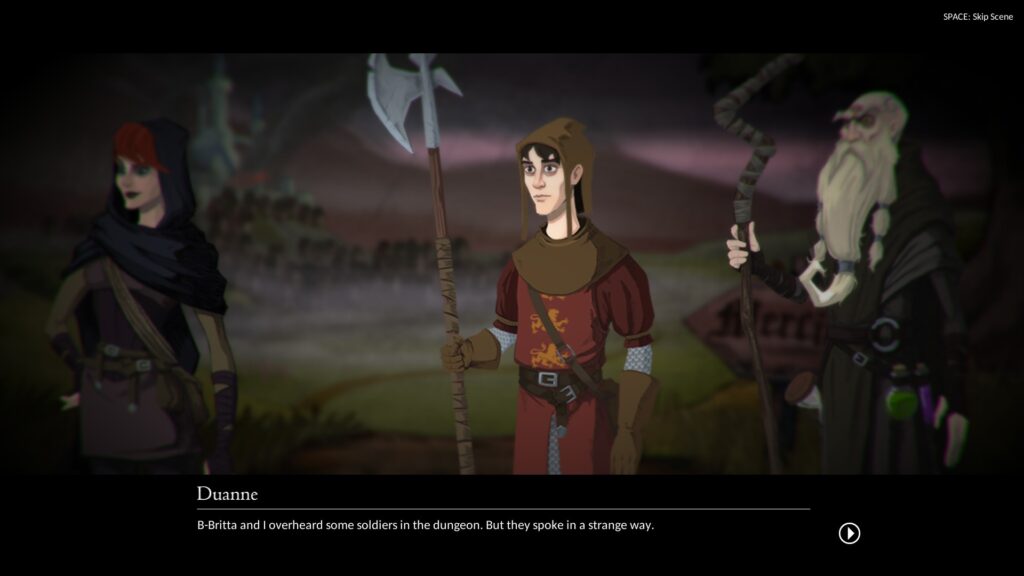
The characters of Sword Legacy Omen are, for the most part, standard fantasy tropes – albeit well-written ones. There’s a foul-mouthed thief, a zealous priest, a Stoic faye archer, and a shouty dwarf. Gorlois is a cackling evil wizard, and Igraine is a damsel in distress. One bright spot among them is Duanne, Uther’s loyal squire. A skinny teenager who expected to spend his life in a monastery rather than as a soldier, Duanne’s earnestness and naïveté are incredibly endearing. His natural curiosity and wide-eyed astonishment at the world make him the most developed character of the bunch, and his scenes are among the best in the game.
Gameplay
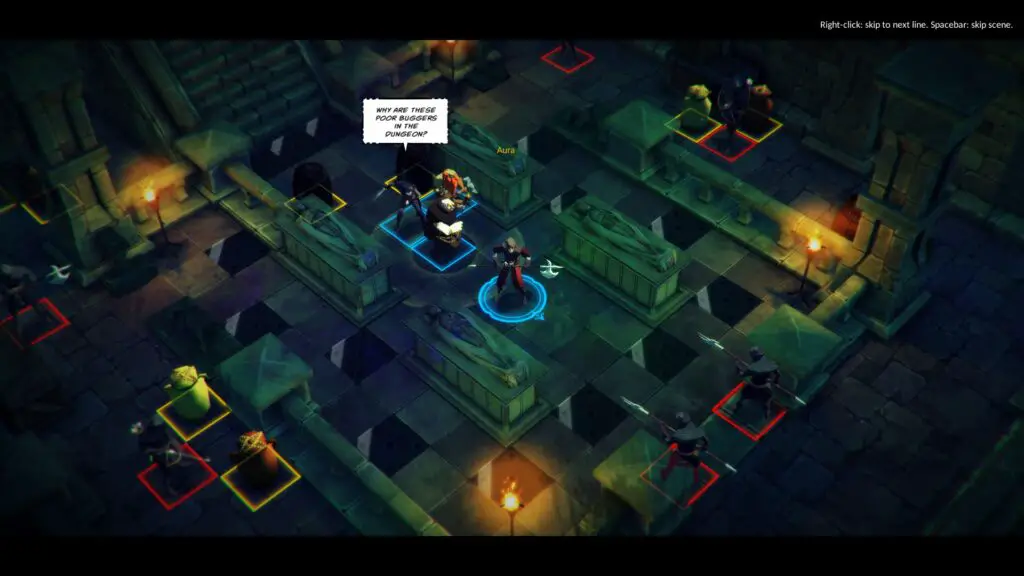
Sword Legacy Omen uses a square grid for its battles – along with action-points. Most characters have 8 of these. Moving one square takes 1AP, while attacks require 2 or 3 – although some can cost as much as 5. There are environmental hazards scattered liberally on every map. These become more common and increasingly dangerous as the game goes on. Using these to your advantage – say, pushing an explosive barrel into a group of enemies – is a great way to even the odds. Especially since most of the time you’ll be badly outnumbered.
All character stats use lower numbers. This is true for both the heroes and the enemies. Getting anything up to 10 or higher is amazing. Including HP – which the game calls Body Points. So, bonuses of +1 are good, and those of +2 are fantastic. Character’s don’t level up – the only way to increase their stats is to find or purchase better gear. That’s an expensive proposition, especially in the early game. However, the advantages are essential to survival, as enemies get progressively tougher. (By the way, Pro Tip: Avoid buying too much new gear for Uther in Act 2. At the end of the act, he receives a unique set of Legendary gear. It makes any prior purchases for him a complete waste of money. Don’t make the same mistake I did!)
While characters don’t gain levels, there is, nevertheless, a shared pool of experience points – or Renown in the game. You can spend Renown to unlock new skills for your team. It isn’t feasible to unlock every skill for every character in a single playthrough. Even if you do defeat every enemy and complete every sub-objective. However – you don’t need to. Each character can only have four skills equipped, in addition to their basic attack. So, in any case, they won’t be able to use every skill they’ve learned. Not all at once, at least. You are able to swap these freely between missions, however. As such, learning more than four may give you some flexibility – even if this isn’t necessary for progress.
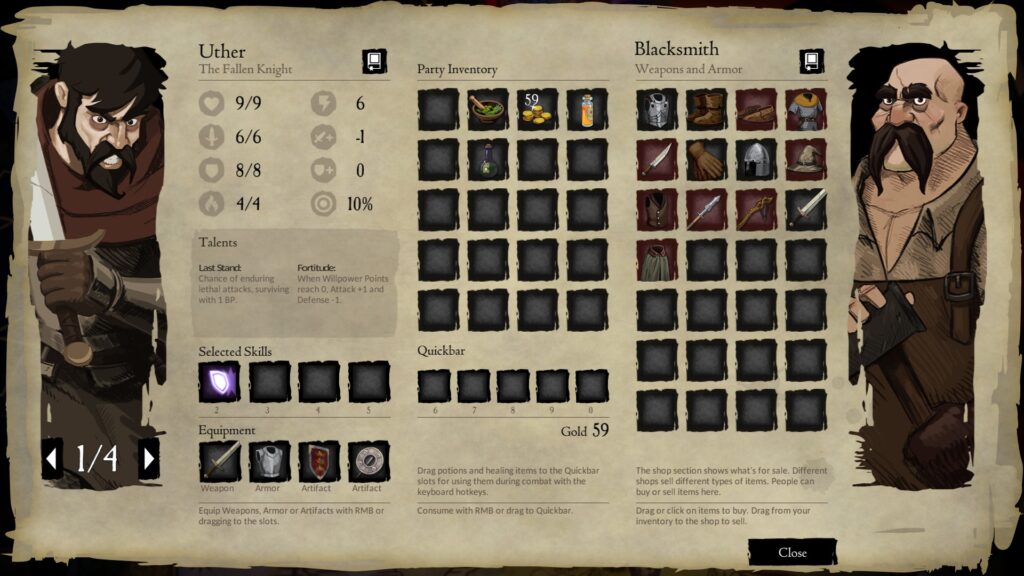
One particularly important stat is Willpower. Once per turn, characters can spend Willpower to gain +2 to their Attack as well as their Defense, in addition to 2AP. Strategic, effective use of Willpower can turn good turns into great turns. However, the stat also acts as the game’s morale system – Taking heavy damage or seeing a teammate fall can cause characters to lose Willpower. If this happens to a character who already lost all of their Willpower left, there’s a chance that they’ll skip their turn or act randomly. The same goes for the enemies. The last few foes in a fight will either be easy to dispatch or turn into dangerous, cornered animals.
Party
Each of the eight heroes fulfills a specific role. This makes party composition supremely important. Especially since you can only bring four of them into battle. Uther is the party’s tank, while Duanne provides close area control using the long reach of his polearm; Merlin has an array of offensive spells and movement abilities, including a teleport with an absurd range; Gwen, the thief and the only lady on the team, has ample movement and is able to sneak past the enemies to backstab them; Kilted barbarian Ferghus hits like a ton of bricks with his ax, and priest Felix provides healing and buffs. There are also two faye members of the group: Flint uses long-range attacks and summons forest beasts, while Gorr restricts enemy movement by creating barriers and has a decent AoE arsenal.
Difficulty
While the game doesn’t have permadeath, a character who falls in battle will receive the Gravely Wounded status. This severely reduces their stats, until the party rests. The heroes can simply rest on the road, but this will use up a camping kit. It costs 50 gold – a fair chunk of change in the early game. However, the more important problem is that doing so almost always results in an encounter the following morning. As such, you can definitely end up worse off than before – if things go poorly. The other option, which is sleeping at an inn, costs a whopping 300 gold. Nevertheless, this restores more Body Points than camping and there’s no risk of an attack. Since most of the game requires you to carefully manage your funds, deciding when and how to rest is critical.
In terms of difficulty, Sword Legacy Omen provides just the right amount of challenge. Much of the strategy revolves around creating choke points and picking off high-priority enemies such as assassins and archers. Each map has unique dangers and more than a few surprises. Except for the final battle, however, the boss fights are underwhelming. They usually boil down to just having your team gang up on the boss and hit them until they fall over. Luckily, there aren’t many of these, and the skirmish battles make up the vast majority of gameplay.
Graphics and Sound

During the story segments of the game, Sword Legacy Omen looks great. The hand-drawn characters feel at home with the setting, and the subtle animation cycles give them just enough life, without breaking the budget. The narration between chapters uses line drawings on parchment, hearkening to the game’s legendary roots and showcasing more of the art style.
In combat, the game looks fine as well, albeit with a cel-shaded look, rather than something hand-drawn. It’s not as lavish as the story parts, but this doesn’t at all take away from the experience. My main issue with the combat visuals is the overkill animations; if you deal damage well over the target’s remaining Body Points, the foe will be dispatched in a particularly brutal manner. Decapitation, being cleft in twain, or having their skull smashed open are all possible grisly demises for the armies of Wessex. Despite the game’s serious tone, these kills feel out-of-place and don’t look good enough to justify their inclusion.
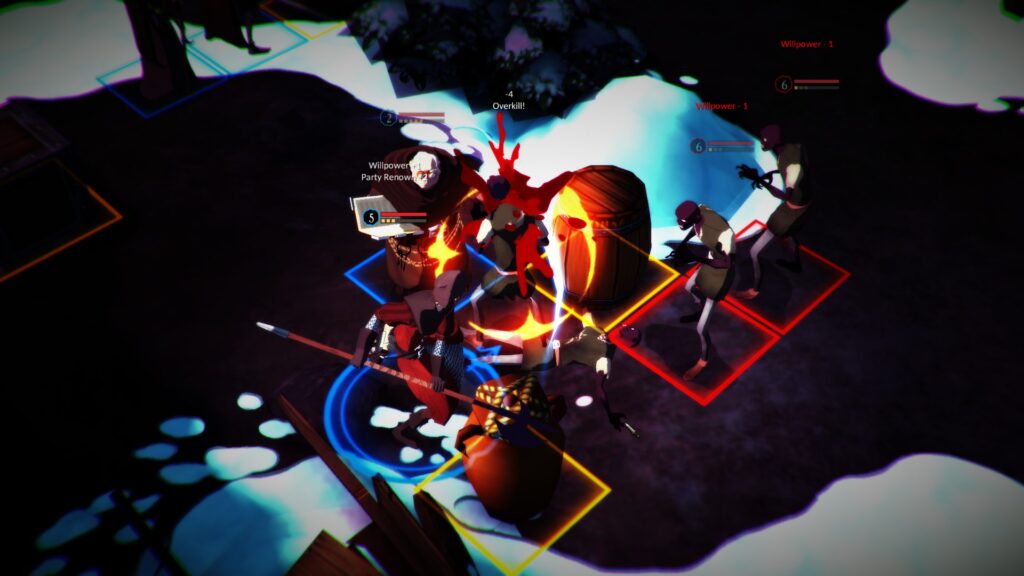
The game’s music has an old-school RPG feel, and wouldn’t be out of place in a game from the mid-90s. The sounds help telegraph what’s happening during the combat – which is particularly useful since speech bubbles will sometimes hide the health bar. The sound of an attack bouncing harmlessly off Uther’s shield is particularly satisfying.
Overall
While Sword Legacy Omen doesn’t do anything revolutionary, it’s still worth a playthrough. Albeit just once – there’s no postgame and not much reason to come back to it after finishing. If you’re in the mood for a fantasy adventure that’s all about swinging swords and fulfilling prophecies, this game is 10-15 hours well spent.


